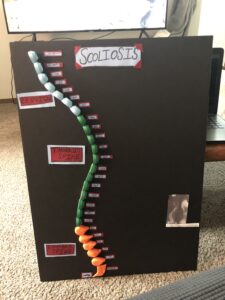This is a spine representing scolioses. You might notice the very large curve that will cause a lot of pain and the body to feel unbalanced. Everything is labeled and each section of the spine is color-coded. The smaller picture to the right is an X-ray of a severe scolioses case.

Jade’s visual aid shows a sharp posterior deflection of the thoracic spine which indicates kyphosis, though I believe it was meant to illustrate c-shaped scoliosis. The two differ in the axis of curvature. Scoliosis is a curve along the sagittal plane while kyphosis is along the coronal plane. Any damage to the spine puts the central nervous system at risk and often reduces mobility and quality of life. Much like scoliosis, the curve shown above is irregular and can negatively impact all organ systems if not properly cared for. The most obvious effect of scoliosis is poor body alignment and posture. Abnormal strain on muscles due to a misshapen spine can be quite painful and individuals suffering from scoliosis and other related ailments are afflicted with chronic pain. A sharp bend in the spine can compress the lungs and make it difficult to properly breathe, the heart may also not function normally as the imbalance posture and reduced oxygen intake create additional stress on the heart. The ribs may also be misaligned leading to deformed ribs on one side. These deformities together can contribute to a ‘humpback’ appearance if left untreated. The poor posture that comes with severe scoliosis also impacts the pelvis and can lead to uneven stress on the legs. Scoliosis can be managed if treated early enough but once scoliosis sets in, the spine will never fully recover. Treatments like surgery, exercise, and back braces can reduce the overall long-term impact of scoliosis and allow for those affected to live relatively normal lives.